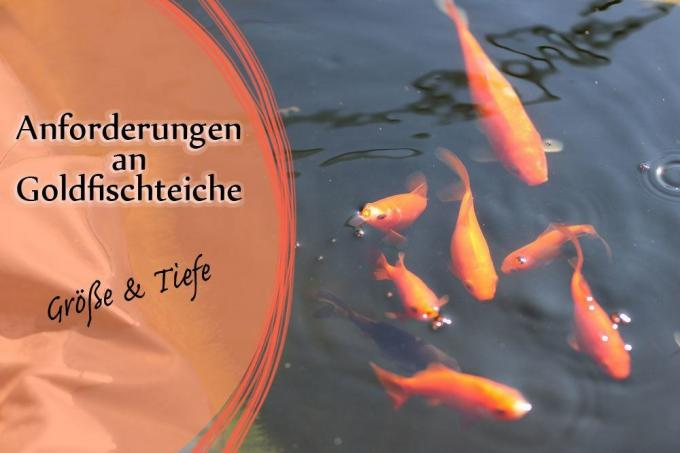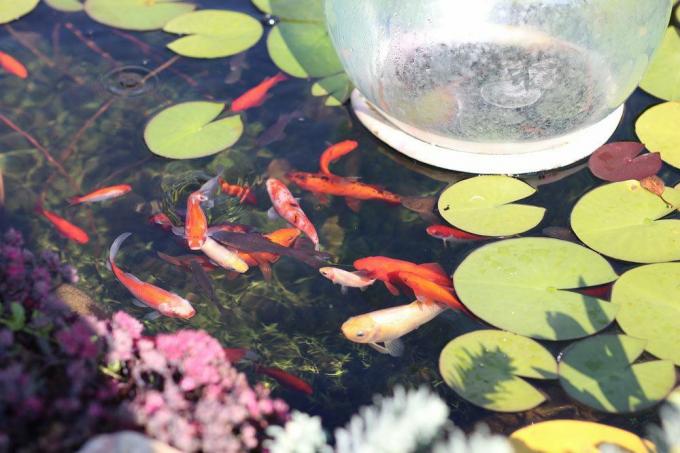
table of contents
- Goldfish in the garden pond
- size
- depth
- volume
Goldfish in the garden pond are an absolute classic. Many people think about keeping the popular carp fish, which are not the easiest fish and have some pond and maintenance requirements. The most important aspects for the fish include the depth and size of the garden pond so that they can feel comfortable and live naturally. Garden ponds that are too small or shallow have a negative effect on vitality.
Goldfish in the garden pond
The size of the pond is an important point when planning the artificially created still water or the number of goldfish in the school. Goldfish are not those smallest fish and with good care they can increase significantly in size. In addition, goldfish multiply due to their extensive content Spawn quickly in larger groups, which can quickly lead to a lack of space in your pond. This can cause the following problems:
- Lack of oxygen
- Stunted stature
- Goldfish jump out of the garden pond
- Dirty water
- strength Algae formation due to excess nutrients from fish droppings
- Predators have an easy job
size
The carp fish (Cyprinidae) can develop in a garden pond of sufficient size and are protected from most of the predators such as cranes, cats and foxes. In addition, you can decorate a larger pond much easier, because Carassius gibelio forma auratus really grows in a pond with many plants and hiding places. Especially when the Bank area If the fish are adequately planted and at the same time have a large, free area in the middle, they will be fine. For this reason, you have to give the animals enough space. The space requirement is calculated using the following values:
- Goldfish length centimeter
- Number of fish
- 3 liters of water per centimeter of length
On average, goldfish grow to be between 30 to 35 centimeters long. You need at least five specimens, as goldfish only feel comfortable in schools of this size. If the sample calculation is based on a swarm with ten adult specimens, the calculation is as follows:
35 (length centimeters) x 10 (number of fish) = 350 (total fish length)
Now the calculated fish length is multiplied by a factor of 3, which in the end is 1,050 liters of necessary water. On average, you need around 100 to 105 liters of water per goldfish to meet the requirements of the animals. However, this amount is not the only value to consider. There are two other points that must be offset against the necessary amount of water:
- Plants water requirement: 1,000 l
- Space requirement for offspring and other pond inhabitants: 1,000 l
In the end, with a school size of 10 goldfish including the aquatic plants, possible spawn and other pond inhabitants, you will reach a size of 3,050 liters. Even narrower garden ponds can be inhabited by the goldfish without any problems, as long as the longest side is not smaller than 150 centimeters. The garden pond must also not be too shallow, which is explained in the next section.

depth
The depth of the garden pond is essential for the fish, as too shallow water does not meet the requirements of the goldfish for the artificial habitat. A garden pond with the ideal depth has many advantages that have a positive effect on the vitality of the fish:
- numerous retreats
- cooling over the summer
- does not freeze through the winter
- easier cleaning
Just the advantages in terms of that wintering are to be mentioned here, because you do not have to relocate the fish and they do not suffer from the winter cold, as they are deep enough in the water. Even a lack of oxygen over the winter is prevented by the depth, especially if you use aids such as an ice preventer. The following points in terms of depth should be kept in mind:
- Minimum depth: 80 centimeters (regardless of the swarm size)
- good range between 100 and 150 centimeters
- ideally 150 centimeters or lower
A depth of over 150 centimeters is of course not possible for many garden owners. For this reason, you should try to keep the pond depth in the range of 100 to 150 centimeters in order to be able to offer your goldfish enough space. The deeper the garden pond, the more goldfish you can keep. If you are a fan of goldfish and want to keep different varieties in one pond, deeper ponds are always preferable.
Note: If you live in a very warm region or if the pond is permanently exposed to the sun, you should definitely make it a little deeper. Since the upper layers of water can heat up quickly when they are directly in the sun, the goldfish have sufficient opportunities to retreat when they swim down can.
volume
The volume is an important parameter that you can use to calculate the final amount of water according to the size of the pond. For this reason, you will find a list of typical pond shapes and how to calculate their area in order to calculate the volume. An invoice in meters is ideal, as this makes the calculation much easier. The following formulas are used here:
- Square and rectangle: side a x side b = area
- Circle: Radius² x Pi = area
- Ellipse: semiaxis a x semiaxis b x Pi = area
After calculating the area of the shape, you need to multiply it by the depth of the planned pond:
Area x pond depth = volume
The final volume is given in cubic meters (m³). You need this value to calculate the final amount of water, which is given in liters (l) for the pond. So you have to convert the cubic meters to liters:
1 m³ = 1,000 l
As a precaution, it is important to include the sloping shape of many ponds in the planning. For example, if you have a certain swarm size in mind, but the volume of the pond is only just within this range, you should either create a larger pond, reduce the planned school size of the goldfish, or choose a smaller species. Because ponds narrow in depth and reduce the actual volume. This means that the fish have less space available, but this is very difficult to calculate. Therefore, you should always have significantly more space than fish in comparison.

tip: If you have a pond made up of several shapes, you also have to calculate the volume from several parts. To do this, calculate each shape individually and add the volume together to arrive at the required amount in the end.



